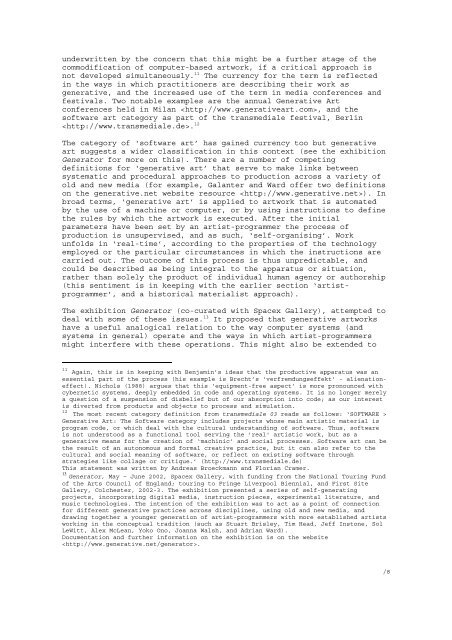anti-thesis: the dialectics of generative art (as praxis) - Geoff Cox
anti-thesis: the dialectics of generative art (as praxis) - Geoff Cox
anti-thesis: the dialectics of generative art (as praxis) - Geoff Cox
Create successful ePaper yourself
Turn your PDF publications into a flip-book with our unique Google optimized e-Paper software.
underwritten by <strong>the</strong> concern that this might be a fur<strong>the</strong>r stage <strong>of</strong> <strong>the</strong><br />
commodification <strong>of</strong> computer-b<strong>as</strong>ed <strong>art</strong>work, if a critical approach is<br />
not developed simultaneously. 11 The currency for <strong>the</strong> term is reflected<br />
in <strong>the</strong> ways in which practitioners are describing <strong>the</strong>ir work <strong>as</strong><br />
<strong>generative</strong>, and <strong>the</strong> incre<strong>as</strong>ed use <strong>of</strong> <strong>the</strong> term in media conferences and<br />
festivals. Two notable examples are <strong>the</strong> annual Generative Art<br />
conferences held in Milan , and <strong>the</strong><br />
s<strong>of</strong>tware <strong>art</strong> category <strong>as</strong> p<strong>art</strong> <strong>of</strong> <strong>the</strong> transmediale festival, Berlin<br />
. 12<br />
The category <strong>of</strong> ‘s<strong>of</strong>tware <strong>art</strong>’ h<strong>as</strong> gained currency too but <strong>generative</strong><br />
<strong>art</strong> suggests a wider cl<strong>as</strong>sification in this context (see <strong>the</strong> exhibition<br />
Generator for more on this). There are a number <strong>of</strong> competing<br />
definitions for ‘<strong>generative</strong> <strong>art</strong>’ that serve to make links between<br />
systematic and procedural approaches to production across a variety <strong>of</strong><br />
old and new media (for example, Galanter and Ward <strong>of</strong>fer two definitions<br />
on <strong>the</strong> <strong>generative</strong>.net website resource ). In<br />
broad terms, ‘<strong>generative</strong> <strong>art</strong>’ is applied to <strong>art</strong>work that is automated<br />
by <strong>the</strong> use <strong>of</strong> a machine or computer, or by using instructions to define<br />
<strong>the</strong> rules by which <strong>the</strong> <strong>art</strong>work is executed. After <strong>the</strong> initial<br />
parameters have been set by an <strong>art</strong>ist-programmer <strong>the</strong> process <strong>of</strong><br />
production is unsupervised, and <strong>as</strong> such, ‘self-organising’. Work<br />
unfolds in ‘real-time’, according to <strong>the</strong> properties <strong>of</strong> <strong>the</strong> technology<br />
employed or <strong>the</strong> p<strong>art</strong>icular circumstances in which <strong>the</strong> instructions are<br />
carried out. The outcome <strong>of</strong> this process is thus unpredictable, and<br />
could be described <strong>as</strong> being integral to <strong>the</strong> apparatus or situation,<br />
ra<strong>the</strong>r than solely <strong>the</strong> product <strong>of</strong> individual human agency or authorship<br />
(this sentiment is in keeping with <strong>the</strong> earlier section ‘<strong>art</strong>istprogrammer’,<br />
and a historical materialist approach).<br />
The exhibition Generator (co-curated with Spacex Gallery), attempted to<br />
deal with some <strong>of</strong> <strong>the</strong>se issues. 13 It proposed that <strong>generative</strong> <strong>art</strong>works<br />
have a useful analogical relation to <strong>the</strong> way computer systems (and<br />
systems in general) operate and <strong>the</strong> ways in which <strong>art</strong>ist-programmers<br />
might interfere with <strong>the</strong>se operations. This might also be extended to<br />
11 Again, this is in keeping with Benjamin’s ide<strong>as</strong> that <strong>the</strong> productive apparatus w<strong>as</strong> an<br />
essential p<strong>art</strong> <strong>of</strong> <strong>the</strong> process (his example is Brecht’s ‘verfremdungseffekt’ - alienationeffect).<br />
Nichols (1988) argues that this ‘equipment-free <strong>as</strong>pect’ is more pronounced with<br />
cybernetic systems, deeply embedded in code and operating systems. It is no longer merely<br />
a question <strong>of</strong> a suspension <strong>of</strong> disbelief but <strong>of</strong> our absorption into code; <strong>as</strong> our interest<br />
is diverted from products and objects to process and simulation.<br />
12 The most recent category definition from transmediale 03 reads <strong>as</strong> follows: ‘SOFTWARE ><br />
Generative Art: The S<strong>of</strong>tware category includes projects whose main <strong>art</strong>istic material is<br />
program code, or which deal with <strong>the</strong> cultural understanding <strong>of</strong> s<strong>of</strong>tware. Thus, s<strong>of</strong>tware<br />
is not understood <strong>as</strong> a functional tool serving <strong>the</strong> 'real' <strong>art</strong>istic work, but <strong>as</strong> a<br />
<strong>generative</strong> means for <strong>the</strong> creation <strong>of</strong> ‘machinic’ and social processes. S<strong>of</strong>tware <strong>art</strong> can be<br />
<strong>the</strong> result <strong>of</strong> an autonomous and formal creative practice, but it can also refer to <strong>the</strong><br />
cultural and social meaning <strong>of</strong> s<strong>of</strong>tware, or reflect on existing s<strong>of</strong>tware through<br />
strategies like collage or critique.’ (http://www.transmediale.de)<br />
This statement w<strong>as</strong> written by Andre<strong>as</strong> Broeckmann and Florian Cramer.<br />
13 Generator, May – June 2002, Spacex Gallery, with funding from <strong>the</strong> National Touring Fund<br />
<strong>of</strong> <strong>the</strong> Arts Council <strong>of</strong> England; touring to Fringe Liverpool Biennial, and First Site<br />
Gallery, Colchester, 2002-3. The exhibition presented a series <strong>of</strong> self-generating<br />
projects, incorporating digital media, instruction pieces, experimental literature, and<br />
music technologies. The intention <strong>of</strong> <strong>the</strong> exhibition w<strong>as</strong> to act <strong>as</strong> a point <strong>of</strong> connection<br />
for different <strong>generative</strong> practices across disciplines, using old and new media, and<br />
drawing toge<strong>the</strong>r a younger generation <strong>of</strong> <strong>art</strong>ist-programmers with more established <strong>art</strong>ists<br />
working in <strong>the</strong> conceptual tradition (such <strong>as</strong> Stu<strong>art</strong> Brisley, Tim Head, Jeff Instone, Sol<br />
LeWitt, Alex McLean, Yoko Ono, Joanna Walsh, and Adrian Ward).<br />
Documentation and fur<strong>the</strong>r information on <strong>the</strong> exhibition is on <strong>the</strong> website<br />
.<br />
/8


